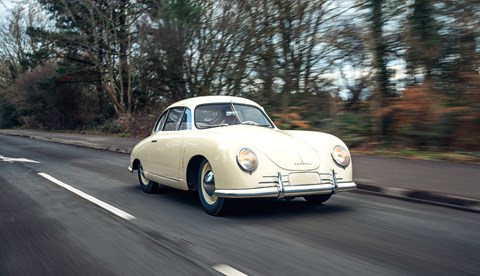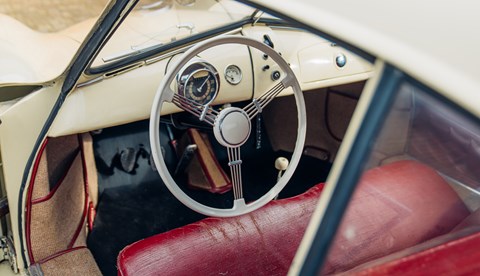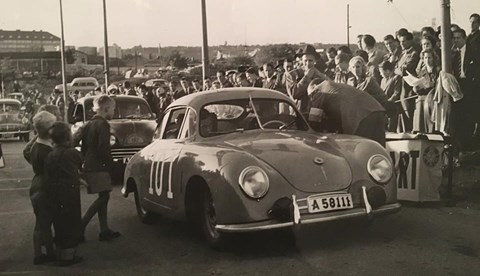► Very early Porsche 356 up for sale
► Available for the first time in 18 years
► We get behind the wheel of $3.5m car
People in the late 1940s/early 50s must have had very thin thighs. I know this little anthropological gem after having tried to get into a Porsche 356 Gmünd – the gap between the bottom of the steering wheel and the seat cushion is so narrow that even a child would struggle to thread themselves across.
This, then, is one of the earliest Porsches, a car from the days when the diminutive, rear-engined sports cars were built not in Germany, but Austria. And also a car that I have lusted after for as long as I’ve known such things exist.
This particular example is not, however, going to be on my shopping list. Not unless my lottery ticket comes in – such is its history that it’s valued at $3.5m by DK Engineering, the firm which is currently selling it.
Why the value? Rarity. It’s chassis number 356/2-0032 – the ‘2’ relates to the fact that it was in the first production run after the prototype ‘1’ car, a mid-engined, ally-bodied 356. The Gmünd production run shifted the engine to the rear, like the VW Beetle on which it was so heavily based but kept the hand-beaten aluminium body panels.

This particular example was completed on 12th June 1950 and an early owner was Gert Kaiser, who gave it its first competition outing in the Rally to the Midnight Sun in Sweden. Naturally, in its 70-plus years of existence it’s been with various owners, including famous collectors in the US, before it came back to the UK in 2007. Since then, it’s been in dry storage but as it’s now up for sale, publicity is required. And who am I to argue with a chance to meet a hero.
The giveaway that this is a Gmünd car lies on the front wheel arch – it’s got indicator levers that pop out as opposed to the later cars gaining indicator lights. It’s also a ‘splittie’, with a bar dividing the windscreen, but this was also on cars as late as 1953.
So what’s it like behind the wheel?
Getting into it, as I said, is not easy. First up you have to negotiate the pull-out door handle (who said the likes of the Kia EV6 and Range Rover were pioneers…), then persuade your right leg under the steering wheel. There’s a key to turn the ignition on and then a button hidden under the dash.

It fires quickly and easily today, only needing a small prod of the accelerator to get some fuel flowing. Floor mounted pedals present an immediate challenge, as your foot tends to roll over the top of them so you have to constantly shift your leg backwards as you attempt double-de-clutching.
Ah yes. The gearbox. In an age of EVs and automatic gearboxes, we really have lost the art of changing gear. Or at least I have. And this 356 takes it to another level as it’s not got synchro on either the way up or down, so each shift change is a lesson in concentration, balance and blind faith.
Dip clutch, shift to neutral, rev throttle (and more than you’d expect, given its long travel), dip clutch and geeeently into gear. The process can’t be rushed because the car prefers patient inputs, but equally, you can’t dawdle because with just 40bhp on tap, you soon lose so much momentum that you almost have to start it all over again, literally from a standstill.
Years ago, I was hankering after a 356 and my dad persuaded me not to because it would be too slow. I’ve always scoffed at that, mainly on account of the fact that I would have quadrupled my money if I had bought it, but as ever, your parents are always right. This 356 is a wonderfully pure thing to drive but it’s anything but rapid. It’s certainly not a car to tackle any dual carriageway in.

We’re on Lambourne’s hills today and as soon as gravity gets involved, the 356 struggles to top 30mph. It’s a lovely air-cooled flat-four beat, with plenty of transmission whine, but for all the aural accompaniment, there’s not much progress being made. I would say you have to carry your speed and make the most of what power there is, but in a car worth more than the village I live in, discretion takes over and I decide to pootle at 30-40mph.
As you’d expect, the steering is wonderfully pure but takes some shuffling, seeing as it has the circumference of the sun. And the ride isn’t quite what I was expecting – normally, historic cars seem to have a bit more float to them, but this 356 is the opposite as it feels quite stiffly sprung. It reacts to everything the road throws at it, with the flipside being you know exactly what’s going on underneath. Should you meet your heroes? 100 per cent, if this is anything to go by. It’s slower than I ever imagined it could be – it makes my 2002 Panda 4×4 feel like The Bloodhound – but as a car to give Porsche a sense of place, it’s difficult not to love it. Whoever the next owner is, please make sure you enjoy it and use it. It’s the least it deserves.